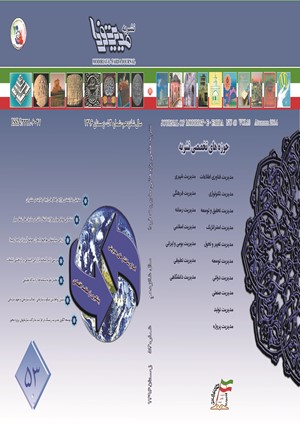تدوين مدل توسعه مهارت هاي مديريتي مديران صنعت خودروي ايران در كلاس جهاني
محورهای موضوعی :عليرضا خجسته پور 1 , محمدرضا پورابراهيمي 2 , سيد اكبر نيلي پور طباطبائي 3
1 - پژوهشگاه شاخص پژوه
2 - دانشگاه تهران
3 - پژوهشگاه شاخص پژوه
کلید واژه: مهارت هاي مديريتي کلاس جهاني صنعت خودرو,
چکیده مقاله :
يكي از دغدغه هاي شركت هاي خودروساز براي پر كردن فاصله ميان وضعيت فعلي و جهاني شدن، نيازبه مديراني است كه داراي مهارت هاي دقيق مديريتي بوده و در جهت آن آموزش هاي علمي و عملي ببينند. امروزه خودروسازي نيز از اجزاي مهم و لاينفك صنعت جهاني است و توليد بيش از 50 ميليون خودرو در سال نشان دهنده اهميّت و جايگاه ويژه اين صنعت مي باشد. لذا در اين پژوهش مدل توسعه مهارت هاي مديريتي مديران صنعت خودروي ايران در كلاس جهاني تدوين و علاوه بر رتبه بندي مهارت هاي مديريتي، ويژگي هاي هر مهارت نيز احصاء و رتبه بندي گرديد. در اين تحقيق براي تدوين ادبيّات موضوع با استفاده از منابع کتابخانه اي و فيش برداري به جمع آوري اطلاعات درخصوص ويژگي هاي مديرجهاني و مهارت هاي مديريتي پرداخته شده است و سپس براساس نظر خبرگان و با استفاده از تكنيك دلفي ويژگي هاي مديرجهاني و مهارت هاي مديريتي مديران براي قرارگرفتن در كلاس جهاني مشخص و دسته بندي گرديدند و با استفاده از آزمون كاپا صحت دسته بندي اين ويژگي ها مورد بررسي قرارگرفت. پس از آن با طرّاحي پرسشنامه ساختاريافته و توزيع آن ميان 470 نفر از مديران صنعت خودروسازي در ايران به بررسي و آزمون مدل پرداخته شد. داده ها پس از جمع آوري با استفاده از نرم افزار اس پي اس اس و آزمون هاي آمار توصيفي، کولموگروف- اسميرنوف و فريدمن مورد تجزيه و تحليل قرار گرفته اند. همچنين برازندگي مدل براساس روش معادلات ساختاري و با استفاده از نرم افزار ليزرل مورد پايش قرارگرفت.
One of the concerns of the automotive companies to bridge the gap between the current situation and globalization is the need for managers who have the strict management skills, and have a scientific and practical training. In this study, the model of development of management skills of auto industry in world-class developed and in addition to ranking managerial skills, characteristics of each skills are ranked and recognized. In this study, for the development of literature using library resources and taking notes to gather information about the features of the global director and managerial skills assessed And then according to the experts and using the Delphi technique characteristic of global managers and management skills of managers were identified and classified. Then, the accuracy of the classification characteristics were investigated through Kappa test. After the questionnaire was designed and distributed to 470 managers of the automotive industry in Iran to investigate and test the model. Data collected using Spss and descriptive statistics, Smirnov, Kolmogorov and Friedman were analyzed. The model fitness based on structural equation modeling and using Lisrel software was monitored.
[1] رحماني, م. نقش مديريت در توسعه اقتصادي. اولين كنگره منطقه اي راهكارهاي توسعه اقتصادي استان كردستان. سنندج: دانشكده علوم انساني دانشگاه آزاد اسلامي واحد سنندج.(1384)#
[2] Marin, D., & Verdier, T. Globalization and the Empowerment of Talent. Department of Economics. Mannheim: Governance and the efficiency of economic system. University of Mannheim. (2004)#
[3] جهانيان, ر. رويكردها،ابعاد و چارچوب توانمندسازي مديران آموزش. پيام مديريت , شماره27 . (1387).صص 145-153.#
[4] M.Steers, R., J.Sanchez, C., & Nordon, L. Management across Cultures. New York: Cambridge University Press. (2010)#
[5] Tamkin, P., Hillage, J., & Willison, R. Indicators of Management Capability: Developing a Framework. Council for Excellence in Management and Leadership. (2010)#
[6] Okoro, E. Cross-Cultural Etiquette and Communication in Global Business: Toward a Strategic Framework for Managing Corporate Expansion. International Journal of Business and Management. Vol 7. (2012). pp 130-138.#
[7] Lee, N. What holds back high-growth firms? Evidence from UK SMEs. Small Business Economics, Vol 43. (2014). pp 183-195.#
[8] ميرسپاسي،ن. مديريت منابع انساني و روابط كار: نگرشي نظام گرا. صاحب اثر. تهران. (1370).#
[9] Katz, RL. "Skills of an effective administer". Harvard business review. Business classic fifteen key concepts for managerial success. (1991).#
[10] Baum,R.J, Lock ,E , A. Smith. K.G. "A multidimensional model of venture growth". Academy of Management Journal 44(2). (2001) PP: 292-303.#
[11] Montel, SJ and Meredith, JRS Shafer, S.MS Sutton, MM. "Core / concepts: project management in practice (with CD) (seconded)". John wiley and sans. New York. (2004)#
[12] Reham A. Eltantawy, Larry Giunipero, Gavin L. Fox. "A strategic skill based model of supplier integration and its effect on supply management performance". Industrial marketing management 38. (2009). PP 925-936.#
[13] Robbins, Stephen. Decenzo, David.D. "Fundamentals of management: essential concepts and applications". Prentice Hall-Inc. (1998)#
[14] Mark T. Schenkel, H. H.-T. Vested interests: how American and Chinese venture capitalists view essential management skills. International Entrepreneurship and Management Journal, 9. (2013). pp 147-165.#
[15] Whetten, D. A., & Cameron, K. S. Developing management skills. Glenview, Ill: Scott, Foresman. (1984)#
[16] Katz, R. Skill of an effective administrator. Harward Business Review. (1974).#
[17] Whetten, P., & Cameron, G. Developing Management Skills. USA: Pearson. (2010)#
[18] Gates, Bill. The Top 10 "qualities" that make a good manager. New York Times. www.nytimes.com. (1997)#
[19] Hopkins, T. H. Ten essential leadership skills for managers. Retrieved from Hopkins Associates Web site: http://www.hopkins-associates.com. (1996)#
[20] Barhem, B., & Younies, H. Ranking the future global manager characteristics and knowledge requirements according to UAE business managers' opinions. Education, Business and Society: Contemporary Middle Eastern Issues, Vol 4. (2011). pp 229-247.#
[21] Petkovski, K. Required Skills and Leadership Characteristics of a Modern Manager in Tourism and Hospitality. Journal of Economics. Vol 3. (2011). pp 91-96.#
[22] Ananthram, S., and A. R. Nankervis. “Global Managerial Skill-sets, Management Development, and the Role of HR: An Exploratory Qualitative Study of North American and Indian Managers.”Contemporary Management Research. 9 (3). (2013). pp 299-322.#


